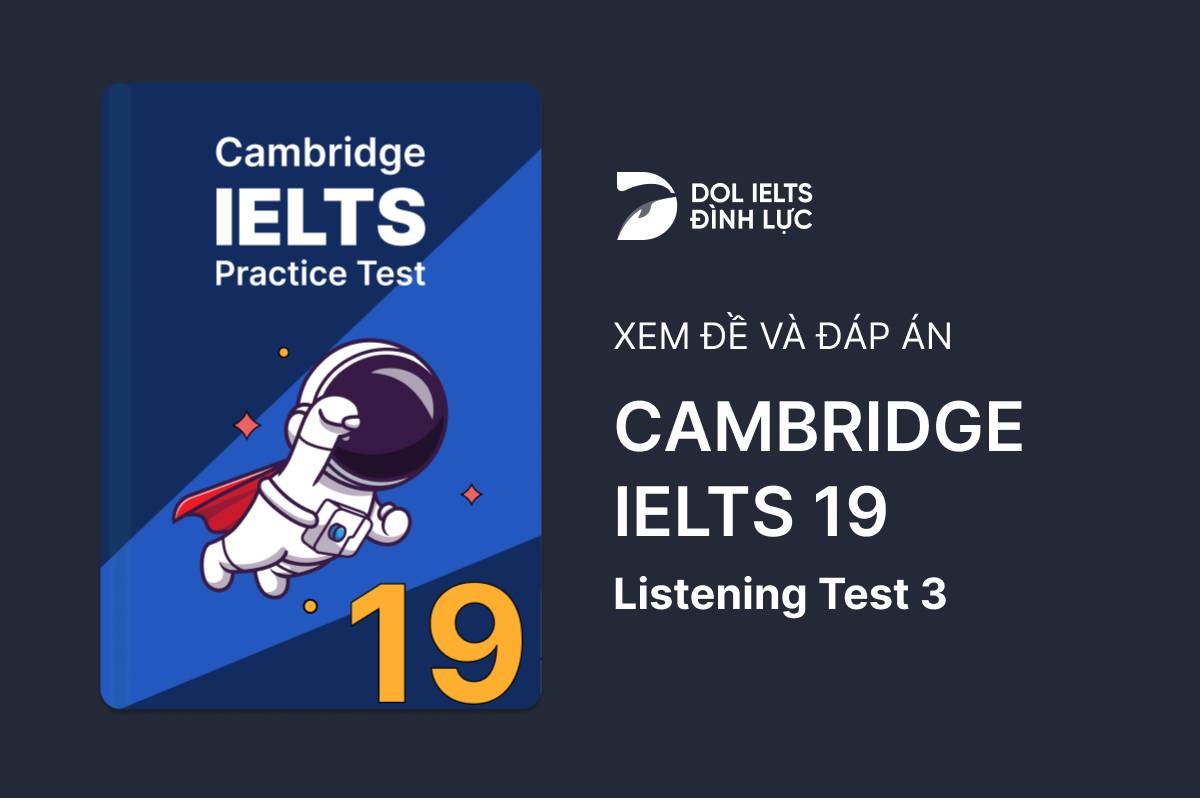Cambridge IELTS 19 - Listening Test 3 With Practice Test, Answers And Explanation
Luyện tập đề IELTS Online Test Cambridge IELTS 19 - Listening Test 3 được lấy từ cuốn sách Cambridge IELTS 19 với trải nghiệm thi IELTS trên máy và giải thích đáp án chi tiết bằng Linearthinking, kèm answer key và list từ vựng IELTS cần học trong bài đọc.
Section
👂️ Bài nghe section 1
Where to go
Kite Place - near the
Fish market
cross the
best to go before
Organic shop
called
below a restaurant in the large, grey building
look for the large
Supermarket
take a
❓ Tapescript section 1
🔥 Đáp án & giải thích section 1
Giải thích chi tiết
Hello Dolbie 🤩 Cùng chinh phục câu hỏi này nhé 😁
🎯 Xác định loại từ cần điền: danh từ (chỉ một địa điểm, vị trí gần Kite Place) ▶️ Thông tin cần nghe ở: "Well, there are plenty of places to buy food in Kite Place - it’s the area by the harbour." ☺️ Cùng xem giải thích nhé: Bài nghe mô tả Kite Place là khu vực nằm gần bến cảng (harbour). Từ thích hợp nhất để điền vào chỗ trống là harbour. ✅ Đáp án đúng: harbour 🧐 Dolbie lưu ý: ❌ bridge
→ Sai vì cầu chỉ là một phần của đường đi đến chợ cá, không phải địa điểm chính xác để mô tả Kite Place.
Chúc Dolbie học tốt và tự tin hơn trong bài thi IELTS nha 🥳💪
Section
👂️ Bài nghe section 2
Superheros
Just do it
Count on me
Speak up
Jump for joy
Sticks and stones
❓ Tapescript section 2
🔥 Đáp án & giải thích section 2
Giải thích chi tiết
Hello Dolbie 🤩 Cùng chinh phục câu hỏi này nhé 😁
🌱 Đọc hiểu câu hỏi: Superheroes → Câu hỏi yêu cầu xác định nội dung chính của hội thảo Superheroes. → Các đáp án cung cấp các yếu tố như trẻ em khuyết tật, vẽ tranh, diễn xuất, cảm xúc tiêu cực. Dolbie cần nghe kỹ để tìm thông tin phù hợp.
▶️ Bắt đầu nghe ở: "There’s a very special event called Superheroes. This is a chance for deaf children to share their reading experiences with author Madeleine Gordon, who is herself hearing impaired."
☺️ Giải thích:
Hội thảo Superheroes dành riêng cho trẻ em khiếm thính, nơi các em có thể chia sẻ trải nghiệm đọc sách với tác giả Madeleine Gordon, người cũng bị suy giảm thính lực.
Thông tin này cho thấy sự kiện này hướng đến trẻ em có khuyết tật.
Section
👂️ Bài nghe section 3
Choose mice which are all the same
Divide the mice into two groups, each with a different
Put each group in a separate cage.
Feed group A commercial mouse food.
Feed group B the same, but also sugar contained in
Take measurements using an electronic scale.
Place them in a weighing chamber to prevent
Do all necessary
❓ Tapescript section 3
🔥 Đáp án & giải thích section 3
Giải thích chi tiết
Hello Dolbie 🤩 Cùng chinh phục câu hỏi này nhé 😁
🌱 Đọc hiểu câu hỏi: How does Clare feel about the students in her Year 12 science class? ("Clare cảm thấy thế nào về học sinh lớp khoa học năm 12 của cô ấy?") → Các đáp án đề cập đến tiến bộ học tập, hành vi kém, sự thiếu hứng thú. Dolbie cần nghe kỹ xem Clare cảm thấy thế nào về học sinh của mình.
▶️ Bắt đầu nghe ở:
"Well, I don’t have discipline problems as such. It's just that they don’t seem to think that science has anything to do with their lives. It’s depressing. They listen to what I say, and I gave them a test last week and the results weren’t too bad, but there’s no real engagement."
☺️ Giải thích:
Section
👂️ Bài nghe section 4
Where microplastics come from
fibres from some
during washing31the breakdown of large pieces of plastic
waste from industry
the action of vehicle tyres on roads
Effects of microplastics
They cause injuries to the
of wildlife and affect their digestive systems32They enter the food chain, e.g, in bottled and tap water,
and seafood.33They may not affect human health, but they are already banned in skin cleaning products and
in some countries.34Microplastics enter the soil through the air, water and
35
Microplastics in the soil - a study by Anglia Ruskin University
Earthworms are important because they add
to the soil.36The study aimed to find whether microplastics in earthworms affect the
of plant.37The study found that microplastics caused:
-
- fewer seeds to germinate
- a rise in the level of
The study concluded:
- soil should be seen as an important natural process
- changes to soil damage by ecosystems and
❓ Tapescript section 4
🔥 Đáp án & giải thích section 4
Giải thích chi tiết
Hello Dolbie 🤩 Cùng chinh phục câu hỏi này nhé 😁
🎯 Xác định loại từ cần điền: Danh từ số nhiều hoặc không đếm được → Từ cần điền phải là một loại vật liệu tạo ra sợi có thể phát tán trong quá trình giặt.
▶️ Thông tin cần nghe ở: "Threads and microfibres detach from synthetic clothing every time they’re put in a washing machine, and these find their way into the water system."
☺️ Cùng xem giải thích nhé:
Câu này nói rằng các sợi nhỏ (microfibres) tách ra từ synthetic clothing (quần áo tổng hợp) trong quá trình giặt.
Từ cần điền phải là clothing vì nó phù hợp với ngữ cảnh của câu.


